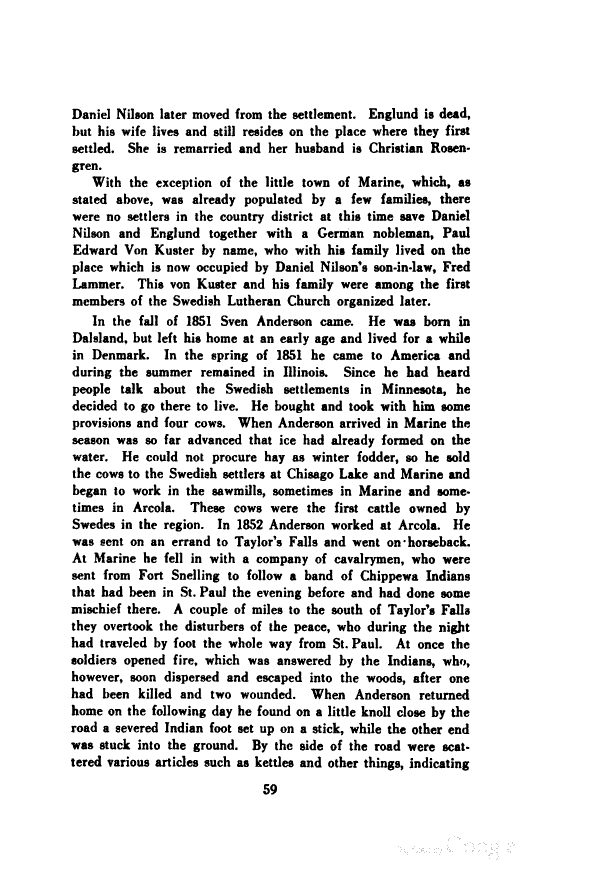
Full resolution (TIFF) - On this page / på denna sida - Sidor ...

<< prev. page << föreg. sida << >> nästa sida >> next page >>
Below is the raw OCR text
from the above scanned image.
Do you see an error? Proofread the page now!
Här nedan syns maskintolkade texten från faksimilbilden ovan.
Ser du något fel? Korrekturläs sidan nu!
This page has been proofread at least once.
(diff)
(history)
Denna sida har korrekturlästs minst en gång.
(skillnad)
(historik)
Daniel Nilson later moved from the settlement. Englund is dead,
but his wife lives and still resides on the place where they first
settled. She is remarried and her husband is Christian Rosengren.
With the exception of the little town of Marine, which, as
stated above, was already populated by a few families, there
were no settlers in the country district at this time save Daniel
Nilson and Englund together with a German nobleman, Paul
Edward Von Kuster by name, who with his family lived on the
place which is now occupied by Daniel Nilson’s son-in-law, Fred
Lammer. This von Kuster and his family were among the first
members of the Swedish Lutheran Church organized later.
In the fall of 1851 Sven Anderson came. He was born in
Dalsland, but left his home at an early age and lived for a while
in Denmark. In the spring of 1851 he came to America and
during the summer remained in Illinois. Since he had heard
people talk about the Swedish settlements in Minnesota, he
decided to go there to live. He bought and took with him some
provisions and four cows. When Anderson arrived in Marine the
season was so far advanced that ice had already formed on the
water. He could not procure hay as winter fodder, so he sold
the cows to the Swedish settlers at Chisago Lake and Marine and
began to work in the sawmills, sometimes in Marine and
sometimes in Arcola. These cows were the first cattle owned by
Swedes in the region. In 1852 Anderson worked at Arcola. He
was sent on an errand to Taylor’s Falls and went on horseback.
At Marine he fell in with a company of cavalrymen, who were
sent from Fort Snelling to follow a band of Chippewa Indians
that had been in St. Paul the evening before and had done some
mischief there. A couple of miles to the south of Taylor’s Falls
they overtook the disturbers of the peace, who during the night
had traveled by foot the whole way from St. Paul. At once the
soldiers opened fire, which was answered by the Indians, who,
however, soon dispersed and escaped into the woods, after one
had been killed and two wounded. When Anderson returned
home on the following day he found on a little knoll close by the
road a severed Indian foot set up on a stick, while the other end
was stuck into the ground. By the side of the road were scattered
various articles such as kettles and other things, indicating
<< prev. page << föreg. sida << >> nästa sida >> next page >>